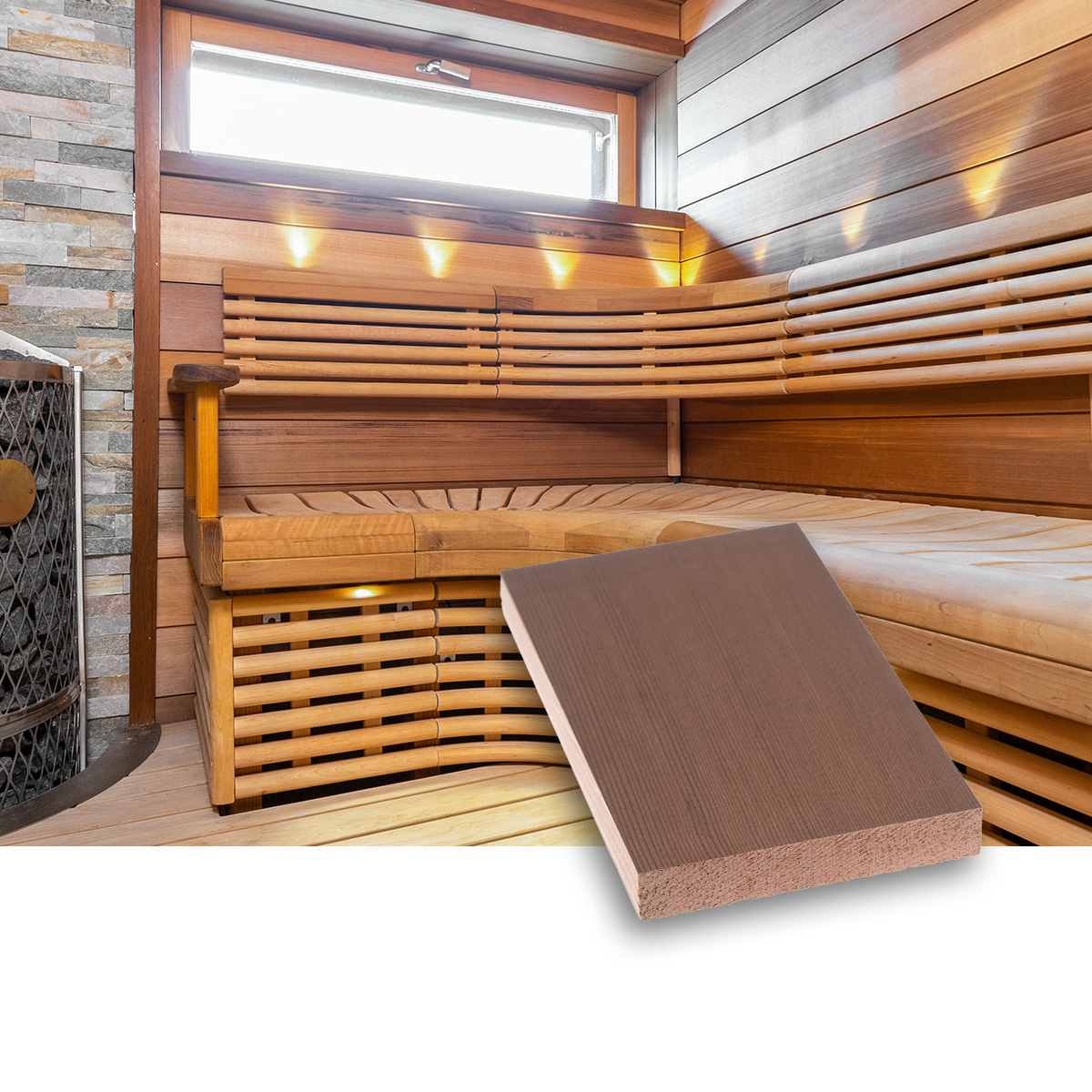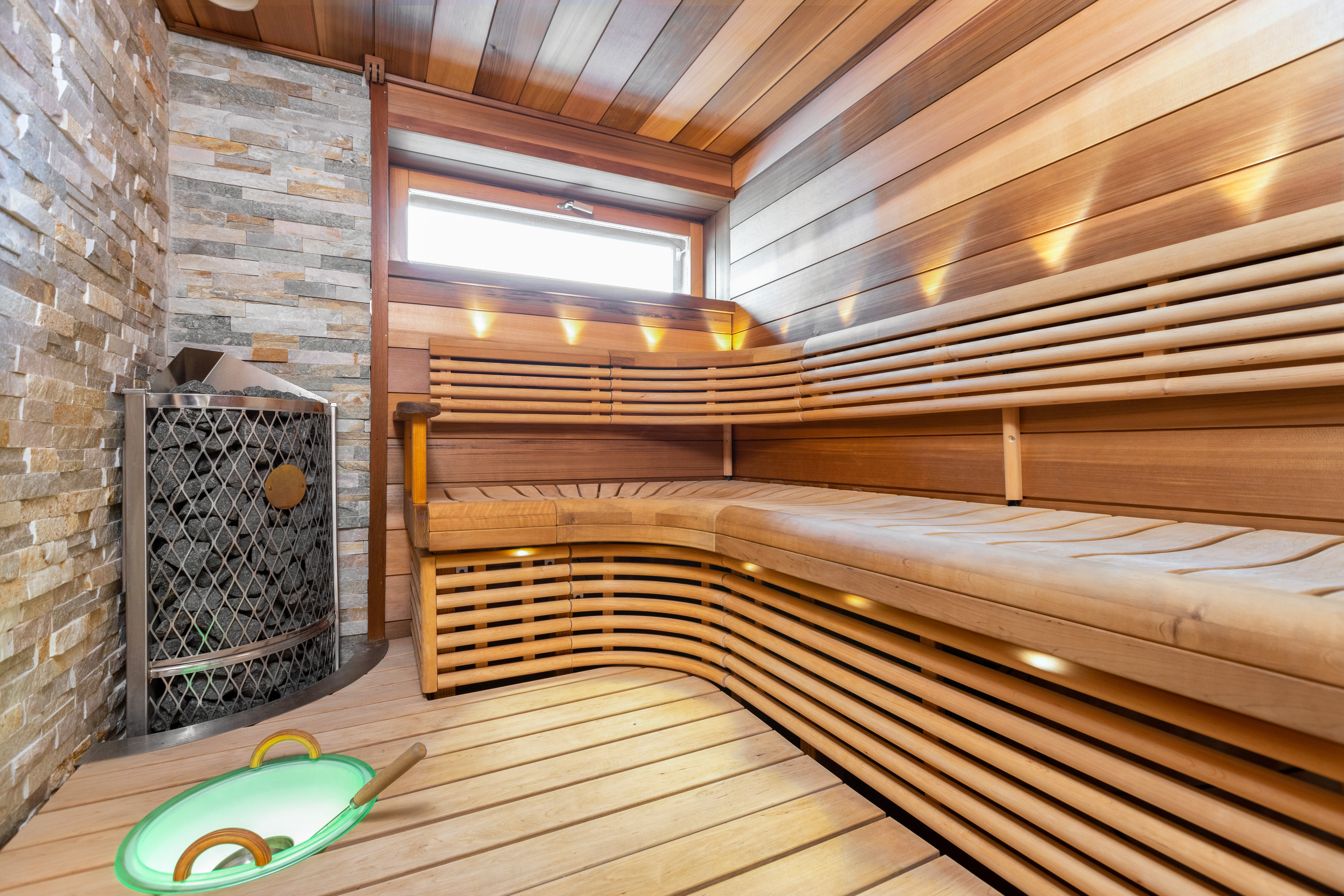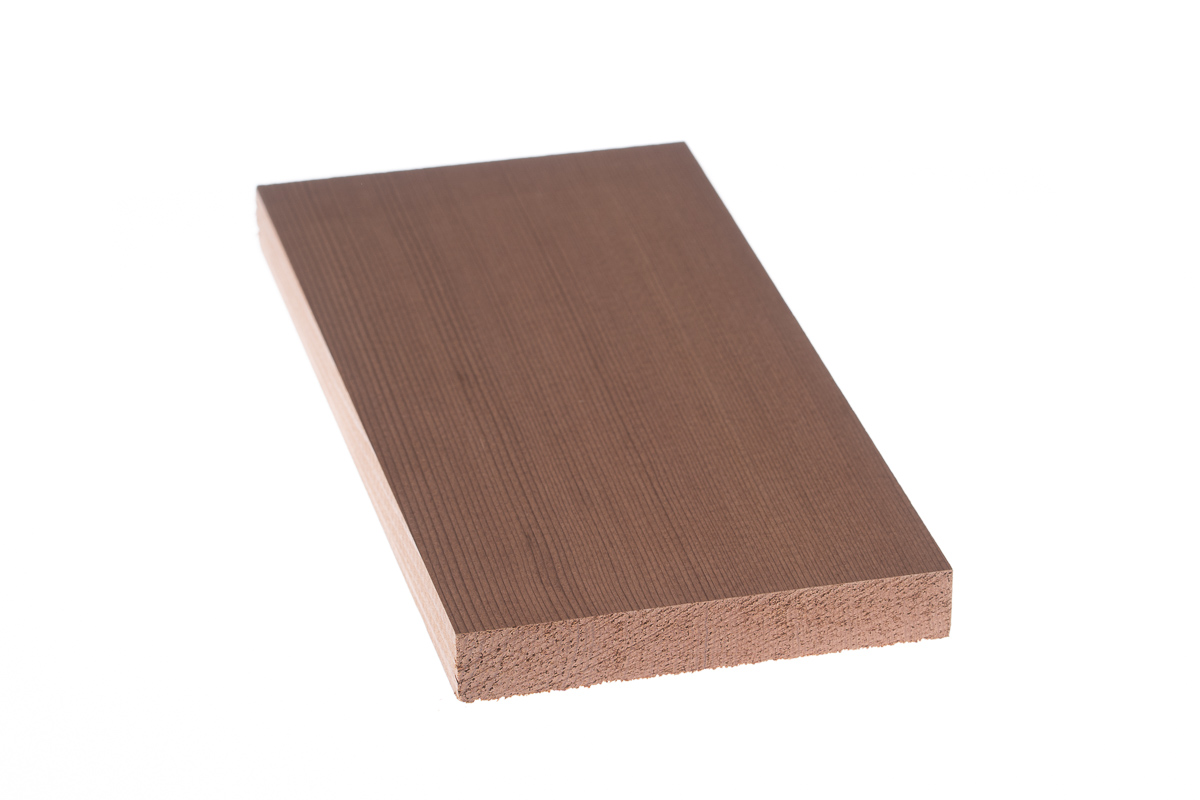





✅ Made from Finnish wood, responsibly produced
✅ Stylish and affordable
✅ Beautiful grain pattern
✅ Easy to work with and finish
✅ PEFC-certified
✅ Responsibly made
✅ Completely natural and safe product
✅ Rich and varied in color
✅ Naturally strong and highly rot-resistant
✅ The royal of sauna materials
✅ Raw material from PEFC-certified sources
| Length | Available | |
|---|---|---|
| 3.05 m | 405.65 m |
Giant cedar is valued in timber construction for its natural decay resistance and attractive appearance. Because the trunks of giant cedars can be several meters in diameter, the final products often show significant color variation. Shades range from pale sapwood to reddish or dark brown heartwood. To achieve a uniform look, panels should be sorted by shade before installation—light panels in one stack, darker or patterned panels in another. During installation, alternate panels from each stack so that colors are evenly distributed. Stainless steel fasteners are recommended due to the wood’s acidity.
Giant cedar is soft, making it easy to shape, but it can dent easily, so careful handling before installation is important. Wood density varies widely, even within a single board, which can make planing uneven and lead to a slightly rough surface. Moisture content can also vary within a piece, though dimensional movement is small compared to spruce or pine. KD drying is applied in Finland by adjusting kiln temperatures, resulting in a moisture content of 8–14%.
Raw Material and Processing
We source only the best blanks from Canada, sized 6” x 6–12” (152 mm x 152–304 mm), which are cut to planing dimensions in-house. This allows most of the material to be quarter-sawn. Blanks are dried in Finland to a target moisture content of 8–14%. Panels and boards are planed according to Finnish RT standards. Product lengths are invoiced in feet, converted to centimeters. Over 96% of giant cedar products are straight-grained (quarter-sawn), and mixed-grain blanks are avoided. The cutting stage allows us to influence grain orientation in the final product.
All our giant cedar products are PEFC-certified. Native to North America, the trees can grow up to 100 m tall with trunks several meters wide. They can live over 1,000 years, though timber trees are typically 300–700 years old, and the largest trunks often have decayed heartwood. Giant cedar has a distinctive natural scent that fades over time.
Despite its exceptional longevity and widespread use, giant cedar is not considered endangered due to its broad distribution.
✅ Finnish wood, responsibly manufactured in Lempäälä
✅ Completely natural and safe product
✅ Beautiful grain pattern
✅ Natural and warm appearance
✅ PEFC-certified
Our product uses pine, a domestic softwood with an elegant grain that creates a natural and warm atmosphere indoors. Easy to work with and finish, pine is ideal for interior applications such as paneling, flooring, trim, and finishing. Its beautiful grain and natural color make it an aesthetically appealing choice for visible surfaces. Our PEFC-certified pine products are responsibly produced and environmentally friendly.
Please note that we deliver our products in bundles. Bundle size is indicated together with stock information on top right corner.
| Tuotenumero | 4246 |
| Tuotenimi | JÄTTILÄISTUIJA 15 x 95 SH A |
| Saatavuus | Tuote poistuu valikoimasta |
| Toimitusaika | 4 päivää, kun tuotetta varastossa |
| Tuoteperhe | Tuuli Sauna |
| Puulaji | Jättiläistuija |
| Vahvuus (mm) | 15 |
| Leveys (mm) | 95 |
| Paino (kg/myyntiyksikkö) | 0,5273 |
| Neliömenekki (m/m²) | 10,00 |
| Hiilijalanjälki (CO2e kg/jm) | 0,06 |
| Hiilikädenjälki (CO2e kg/jm) | -1,08 |
Storage of Indoor Products
- Products should be acclimated in the room where they will be installed for 1–2 weeks.
- Products should be stored horizontally in unopened packages and elevated at least 30 mm from the surface.
- During storage, humidity must not exceed the normal moisture level of the installation site. The temperature should be higher than the outdoor temperature.
Note that any wet work in the space will significantly increase humidity. If products are stored in the same room, they may swell. Conversely, a construction heater dries the air and can shrink the product. Rapid drops in humidity may cause cracking in the wood. Also, if packages have been tightly stacked, the moisture content of the packages in the center and on the outside of the stack may differ.
Giant arborvitae is soft and can be easily dented, so it should be handled carefully before installation.
Considerations for Installing Giant Arborvitae Products
To achieve a uniform finish, it is recommended to sort the panels by color before installation. For example, place lighter panels in one stack and darker or patterned panels in separate stacks. During installation, alternate panels from each stack so that each color is evenly distributed across the surface. This ensures a consistent and even-looking panel finish.
It is recommended to use stainless steel fasteners during installation due to the wood's natural acidity.
The density of the wood can vary significantly, even within the same board. This may present challenges when planing giant arborvitae, potentially causing rougher areas after planing. Similarly, moisture content can vary within a single piece. However, seasonal movement due to moisture is relatively minor compared to spruce or pine. During production, the product undergoes KD (kiln drying) treatment by controlling the kiln temperature, resulting in a moisture content of 8–14%.
Sauna Bench Installation
Sauna benches are available in a wide range of wood types. Benches are usually left in their natural wood color, so the choice of wood affects the final appearance. Dark woods are heat-treated, while light woods are untreated. Wood color is influenced by UV light, humidity, and temperature changes. Over time, dark heat-treated wood will lighten, and light wood will darken. Benches should always be treated before use with either paraffin oil or sauna wax, which also affects the final shade.
In addition to saunas, the boards can be used in furniture and other applications. Always use a treatment suitable for indoor or outdoor use, which both protects the wood and finishes the surface.
Installation Guidelines
- Plan the installation direction and possible joint locations.
- Use appropriate fasteners for the application.
- Benches should always be screwed from underneath.
- Sort boards by color or knot distribution so that they are evenly distributed across the surface.
- Consult a professional installer if necessary.
Additional Considerations
- Leave adequate gaps between boards for proper drying and easy cleaning.
- Install boards with the better side facing up.
- Use stainless steel screws for fastening.
- Pre-drill screw holes to prevent cracking.
- Ensure benches have sufficient support; they must not be mounted on panels alone.
- Sorting boards by color or knots before installation makes it easier to distribute them evenly across the surface.
Treatment
- Saunas benches are best treated with paraffin oil; sauna wax is an alternative.
- Oil treatment should be repeated 1–5 times per year depending on sauna use.
- Always treat benches before first use, and repeat oiling after each sauna cleaning.
- Apply treatment along the entire length of each board to avoid visible seams.
- Follow the manufacturer’s instructions for the treatment product.
Care During Use
- Use sauna towels or mats to protect the benches, but ensure they do not stain the wood.
- Do not leave textiles on the benches to dry after use; moisture can leave dark marks and pose a fire risk.
- Regular cleaning keeps surfaces in good condition and looking attractive.
- Maintenance intervals depend on the product type and installation environment.
- After sauna use, keep the sauna on for at least 30 minutes to allow the wooden structures to dry.
Handling of Giant Thuja
Paraffin or another type of oil treatment protects the wood from getting dirty and makes it easier to keep clean. Oil treatment always deepens the wood’s natural tone. To see the final shade, you can first test the treatment on, for example, a sample piece. Giant thuja does not need separate treatment against mold or rot. The wood contains natural chemicals that repel insects, decay fungi, and mold fungi. The wood has good fire resistance and burns poorly.
Maintenance and Care of Giant Thuja
Giant thuja benches should be cleaned at least once a year. After washing, make sure the wood can dry thoroughly. Chlorine treatment or pressure washing is not recommended.
Sauna Cleaning
A sauna stays clean when you shower before going in and use a bench towel. Keep the heater on for a short time after bathing so the sauna dries well. If possible, ventilate the sauna after every use. When vacuuming other areas of your home, also vacuum the sauna floor.
Thorough Sauna Cleaning
A deeper cleaning is needed once or twice a year. Follow these steps:
- Clean the sauna when it is cool so cleaning agents do not dry too quickly on surfaces.
- Vacuum or remove dust and loose debris from the floor and benches with a long-handled brush or scraper. Also brush the ceiling and walls.
- Wet the wooden surfaces with warm water to open the pores. Wash with a general-purpose cleaner or sauna cleaner using a soft brush or scrubbing pad. Rinse with cold water to close the pores.
- When scrubbing wood, work in the direction of the grain. Use a soft deck brush, for example. Wet and wash walls from top to bottom.
- Avoid chlorine-based cleaners, as chlorine can absorb into the wood and later be released into the air when heating the sauna.
- Air the sauna well.
- After cleaning, keep the sauna heater on for a short time so it dries completely.
Sauna benches are traditionally made from wood, which is often the superior choice for durability, heat conductivity, and appearance. Although wood is a strong material, wooden products for wet areas—such as bench boards—always require surface treatment to withstand use. In sauna conditions, all interior materials are under heavy strain because both humidity and temperature fluctuate rapidly and significantly. For example, paraffin oil treatment helps bench boards better endure heat and moisture changes, extending their service life considerably.
When choosing bench material, you should consider not only appearance but also the properties of each wood species. Aspen and alder, for instance, are often pleasant as bench materials because they conduct heat slowly and therefore remain cooler even at high sauna temperatures.
Wood is a nuanced natural material—every board is unique and changes over time. This makes it an excellent choice for creating a visually warm sauna atmosphere. Bench colour is up to the builder; popular shades range from the dark brown of heat-treated wood to the nearly white tone of aspen. Surface treatments can alter or deepen the colour, allowing for a completely unique design tailored to the user’s taste.
Bench Design
- Choose the wood species to be used
- Decide the desired board width
- Determine the installation direction of the boards
- Decide the type and placement of the sauna heater
Benches can incorporate multiple board widths and more than one wood species. For a harmonious result, consider the colour, width, and profile of the wall panelling as well.
Note: Heat-treated aspen is not suitable for continuously heated saunas. Heat-treated alder is suitable for such saunas and has a similar tone to heat-treated aspen. The scent of freshly installed heat-treated radiata pine can be strong at first, making immediate sauna use unpleasant; thorough ventilation will reduce the smell.
Giant Thuja as a Construction and Interior Material
Giant thuja is valued as a building and interior material for its unique appearance and excellent moisture resistance, making it an ideal choice for sauna paneling or benches.
Because the trunk of a giant thuja can reach several meters in diameter, the finished products typically feature significant colour variation. The sapwood has a reddish tone, while the heartwood is dark brown. This natural variation creates a beautiful, vibrant surface for interior walls and ceilings. During installation, panels should be sorted so that different shades are evenly distributed across the entire area, ensuring a harmonious overall look.
The Best You Can Choose for a Sauna!
The natural colour variation of giant thuja—also known as western red cedar—creates a stunning, lively surface for both interior walls and ceilings. Thanks to its excellent moisture resistance and minimal dimensional changes, giant thuja is an ideal material for sauna paneling and benches.
We source only the best possible timber from Canada. The blanks are 6” x 6–12” (152 mm x 152–304 mm) and are sawn to planing-ready dimensions in-house. This allows us to ensure the wood is radially sawn. The blanks are also dried in Finland to a target moisture content of 8–14%.
We plane the panels and bench boards according to Finnish RT card dimension guidelines, and all giant thuja panels feature a hidden nailing tongue. Product lengths are billed based on foot measurements, converted directly to centimeters with exact precision. Over 96% of our giant thuja products are straight-grained (radially sawn). We aim to avoid mixed-grain blanks (containing both radial and vertical grain). By controlling the cutting phase of the blanks, we can strongly influence the final grain direction of the product.
Lauta.fi delivers product sample pieces to both consumer customers and professionals, such as architects, interior architects and designers, construction industry and procurement professionals.
If you are interested in ordering one or more sample pieces, please contact our sales department via email lauta@lauta.fi or phone +358 3 3123 6000 (On weekdays 8-16).